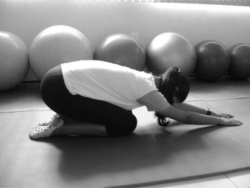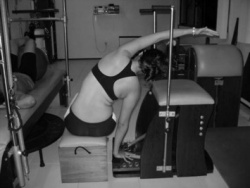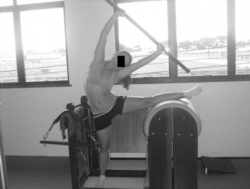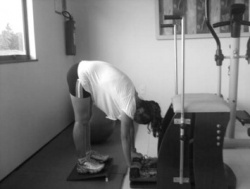Scoliosis
What Are My Treatment Options?
Surgical Treatment?Alternative treatments to prevent curve progression?
What Are My Treatment Options?

Posterior Approach

Anterior Approach
Surgical Treatment
Surgical treatment is used for patients whose curves are greater than 45º while still growing or greater than 50 º when growth has stopped. The goal of surgical treatment is two-fold: First, to prevent curve progression and secondly to obtain some curve correction. Surgical treatment today utilizes metal implants which are attached to the spine, and then connected to a single rod or two rods. Implants are used to correct the spine and hold the spine in the corrected position until the spine segments which have been operated on are fused as one bone. The surgery can be performed from the back of the spine (posterior approach)through a straight incision along the midline of the back or through the front of the spine(anterior approach). Although there are advantages and disadvantages to both approaches, the posterior approach is utilized most often in the treatment of AIS and can be utilized for all curve types. The anterior approach is an option when a single thoracic curve or a single lumbar curve is being treated. Many factors go into the decision as to the surgical approach and your doctor will review the options and choose the best approach for you.
Following surgical treatment, no external bracing or casts are used. The hospital stay is generally between 5 and 7 days. The patient can perform regular daily activities and generally returns to school in 3-4 weeks. Depending on the activities of the patient, full participation is allowed between 3 and 6 months after surgery.
These three treatment methods are well accepted and well studied.
Alternative treatments to prevent
Alternative treatments to prevent curve progression or prevent further curve progression such as chiropractic medicine, physical therapy, yoga, etc. have not demonstrated any scientific value in the treatment of scoliosis. However, these and other methods can be utilized if they provide some physical benefit to the patient such as core strengthening, symptom relief, etc. These should not, however, be utilized to formally treat the curvature in hopes of improving the scoliosis.
Physical Therapy Management
Scoliosis is not just a lateral curvature of the spine, it’s a three dimensional condition. To manage scoliosis, we need to work in three planes: the sagittal, frontal and transverse. Different methods have already been studied.[4]
The conservative therapy consists of: physical exercises, bracing, manipulation, electrical stimulation and insoles. There is still discussion about the fact that conservative therapy is effective or not. Some therapists follow the ‘wait and see’ method. This means that at one moment; the Cobb degree threshold will be achieved. Then, the only possibility is a spinal surgery.[5]
The conservative therapy consists of: physical exercises, bracing, manipulation, electrical stimulation and insoles. There is still discussion about the fact that conservative therapy is effective or not. Some therapists follow the ‘wait and see’ method. This means that at one moment; the Cobb degree threshold will be achieved. Then, the only possibility is a spinal surgery.[5]
The physical therapist has three important tasks: to inform, advice and instruct.
For the treatment of scoliosis, it’s not only important to do the correct exercises but the physical therapist also needs to inform the patient about his/her situation (if the patient is still a child, then he needs to inform the parents too). An educational program makes sure that the therapy accuracy from the patient improves. [6]
For the treatment of scoliosis, it’s not only important to do the correct exercises but the physical therapist also needs to inform the patient about his/her situation (if the patient is still a child, then he needs to inform the parents too). An educational program makes sure that the therapy accuracy from the patient improves. [6]
Some physical therapists recommend a brace to prevent the worsening of the scoliosis. An often used brace is the Milwaukee brace. Nevertheless the evidence for bracing is controversial. Maruyama T., Nakao Y. and Takeshita T. studied the effect of bracing in a review (2011). They compared brace treatment with no-treatment, other conservative treatments or surgery. The analyzed outcome measures were the radiological progression of the curve, surgery and quality of life. Results demonstrate that brace treatment is better than no-treatment (observation) or electrical stimulation. There is also no negative influence on the quality of life of patients with an idiopathic scoliosis. We can conclude that bracing is recommended as a treatment for female patients with a Cobb angle of 25-35°. The evidence level of some studies in the review was limited, so further research is necessary.[7]
In the literature there is evidence that exercises have beneficial effects on patients with idiopathic scoliosis.[8] [9]
The aims of the physical therapy consist of:[10][[8][9]
• Autocorrection 3D
• Coordination
• Equilibrium
• Ergonomy
• Muscular endurance/ strength
• Neuromotorial control of the spine
• Increase of ROM
• Respiratory capacity/ education
• Side-shift
• Stabilisation
In the literature there are different exercise therapies.
• Autocorrection 3D
• Coordination
• Equilibrium
• Ergonomy
• Muscular endurance/ strength
• Neuromotorial control of the spine
• Increase of ROM
• Respiratory capacity/ education
• Side-shift
• Stabilisation
In the literature there are different exercise therapies.
An important one is the conservative three-dimensional Schroth method consisting of curve-specific exercises and corrective breathing techniques. The purpose of these exercises is to derotate, deflex and to correct the spine in the sagittal plane while elongating the spine. The patient needs to be focused about re-establishing spinal symmetry. The key to a successful therapy is to work consistently to correct the spine. Another – difficult- part of the therapy is to learn to shorten the muscles on the convex side of the spine and lengthen the muscles on the concave side of the side. This because the muscles become imbalanced on opposite sides.[4]
The exercise position approaches the functional/structural threshold. Schroth therapy takes advantage of the overcorrected positions. Basic corrections are reviewed by using mirrors in front and at the back of the patient. This posture requires concentration and coordination, applying the correct breathing, and well-adapted muscle length and tension.[11]
But there are also other exercises that have been found effective. Scientific Exercises Approach to Scoliosis (SEAS) exercises is for example been found effective in reducing the rate of progression of scoliosis compared with usual care and help to avoid brace prescription. [8] [12] [13]
The SEAS exercises are, according to the Italian Scientific Spine Institute (ISICO), based on a specific form of Active Self-correction (ASC), that is taught individually to each single patient. This is to achieve the maximum possible correction. ASC is then associated with stabilising exercises that include neuromotor control, proprioceptive training and balance. The exercises are also incorporated into their daily living activities. SEAS approach does also involve the parents. They are getting together with the patiënt a cognitive-behavioral approach to maximize compliance to treatment.[8][14]
We mentioned earlier that one of the aims is respiratory capacity/education. The severity of the curvature can cause a pressure on airways and lungs. The patient can experience trouble while breathing. Therefore the therapist must insert breathing exercises to complete his/her management. If the risk of pulmonary dysfunction (as a result of the pressure of the spine) is too high, surgery is indicated.[9][15]
Solache-Carranco and M.G. Sánchez-Bringas (2011) studied the effectiveness of a respiratory rehabilitation program in children with scoliosis. This are the techniques that they used:
- Respiratory education techniques (abdominal-diaphragmatic ventilation, thoracic mobilisation, ventilation at rest and during activities of daily living). This for mobilisation and prevention of stiffness of chest and skeletal muscles.
- Postural drainage and vibration to evacuate mucus and decrease the resistance of the airways.
- Relaxation techniques to make sure that the patients would have better control of respiration (to counteract dyspnea).
They found that the respiratory rehabilitation had a positive effect on increasing pulmonary function of children with scoliosis.[16]
- Respiratory education techniques (abdominal-diaphragmatic ventilation, thoracic mobilisation, ventilation at rest and during activities of daily living). This for mobilisation and prevention of stiffness of chest and skeletal muscles.
- Postural drainage and vibration to evacuate mucus and decrease the resistance of the airways.
- Relaxation techniques to make sure that the patients would have better control of respiration (to counteract dyspnea).
They found that the respiratory rehabilitation had a positive effect on increasing pulmonary function of children with scoliosis.[16]
Management of non–structural scoliosis[17]
Pilates: This intervention was divided in three parts:
1. Preparation (warming up + stretch)
Warming –up consisted of eight minutes walking on a treadmill or an elliptical machine.
After the warming –up each patient had to do some stretching exercises:
After the warming –up each patient had to do some stretching exercises:
- Spine forward stretching:
- The patient sits on the floor with a straight back and the legs stretched. The patient has to bring her trunk forwards
- Goal: Stretching the posterior muscle chain and mobilizing the vertebral spine
- Upper rolling
- The patient lies supine with the arms besides the body. The patient has to raise both legs till the toes touches the floor. Than this person has to unroll her spine slowly (vertebra by vertebra)
- Goal: stretching the posterior chain, mobilizing the spine and strengthen the abdomen
- Child position
- The patient sits in a four support position and has to stretch her spine, her arms are stretched and she has to push her hands against the floor. Then she has to lower her spine.
- Goal: Stretching the thoracic paravertebral, lumbar and gluteal regions and mobilizing the vertebral spine
<span style="line-height: 1.5em;" />- Forward leg pull
- The patient sits in a four support position. Then she has to raise the right arm and leg while the spine stays aligned. Than the same exercise but change arm and leg.
- Goal: Stretching the concavity of the vertebral spine.
2. Specific exercises:
For these exercise they made use of Swiss balls, FlexBall Quarks,.. It’s important that the patients learn to breathe right during exercise.
- Hip movements with a large ball (65 cm diameter)
- Hip movements with a large ball (65 cm diameter)
- Goal: Strengthening the gluteal muscles and developing the equilibrium
- Inverted abdominal skills with a ball (55 cm diameter)
- Goal: Strengthening the infraabdominal region and the ischiotibial muscles.
-Rising into a seated position:
- Goal: Strengthening the M. rectus abdominis
- Lateral spine movement on a step chair with a spring of 0.1410 kgf positioned in the rings to provide major resistance
- Goal: Stretching the lateral muscle chain according to the direction of convexity of the scoliosis
- Lateral spine movement:
- Goal: Stretching the lateral muscle chain according to the direction of convexity of the scoliosis
- Flexibility on the step chair with a spring of 0,1410 kgf positioned in the rings to provide major resistance:
- Goal: Mobilize the spine and stretching the paravertebral thorax and lumbar muscles
3. Returning to a relaxed position (relaxation) :
It consist out three movements, the patient has to repeat each exercise three times for five minutes.
All exercises has to be performed rapidly. The purpose of these exercises are metabolic recovery and relaxation of the used muscles.
All exercises has to be performed rapidly. The purpose of these exercises are metabolic recovery and relaxation of the used muscles.




Nenhum comentário:
Postar um comentário